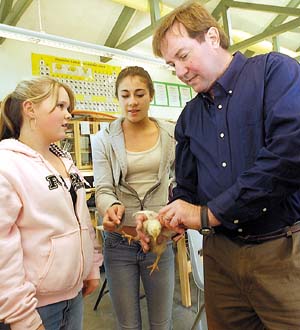
While schools nationwide are suffering from a shortage of
qualified agriculture education teachers in a time when the field
is booming, San Benito County ag teachers say they wouldn’t trade
their jobs for anything and don’t expect the shortage to last very
long.
While schools nationwide are suffering from a shortage of qualified agriculture education teachers in a time when the field is booming, San Benito County ag teachers say they wouldn’t trade their jobs for anything and don’t expect the shortage to last very long.
“As a teacher, I’ve met guys (ag teachers) a year away from retiring who are still interested in what’s going on, even though it’s an ever-changing field,” said Renee Reed, an ag teacher at San Benito High School who was inspired to teach after a positive FFA experience as a high school student. “They’re into the field and they’re into their students, whatever it takes.”
According to the Associated Press, the most recent study done for the National Association of Agricultural Educators estimated that 1,175 new ag teachers were needed nationwide in fall 2001, but only 693 new graduates were looking for teaching positions.
“The program really appeals to kids because it’s hands-on learning,” Reed said. “They have a connection outside of class with the FFA, they’re learning leadership skills and they have a chance to compete up and down the state… As the programs keep changing they keep growing.”
SBHS’ ag program has been at the heart of the school since the department was founded in 1928, and student enrollment has more than doubled from 85 to 200 in the past three years alone. The high school offers six different ag classes; many of them fulfill chemistry, biology and economics requirements for both graduation requisites as well as University of California and California State University admission. Each student enrolled in an ag class is also a member of the FFA, which currently boasts an all-time high nationwide membership of 490,000.
“You have a much more diverse group of students these days,” Reed said. “They’re not just interested in the topic, they’re interested in their education and what they can do with ag in the future.”
On the other end of the spectrum, Anzar High School in San Juan Bautista is just beginning to get their ag program off the ground. Due to the small size of the school, the school can’t quite fit a full-fledged ag program into their regular schedule, said ag teacher Bruce Pirl. But an ag class is offered during zero period beginning at 7:15am for interested students, as well as an intensive “intersession” ag course offered between semesters. Pirl said about 25 students participated in the intersession course, and just under a dozen students show up every morning for his zero period ag class.
“There’s this big focus on testing and standards right now, but there will always be those kids who are born to be welders, builders or aggies,” he said. “The FFA has always been about academics, and our school – which started off as a very academic school – is finally starting to recognize that and make room for some good vocational programs.”
Due to the fetal stages of the program, Pirl, who started his career as an ag teacher and later incorporated special education to his class load, is doing most of the work getting a new ag course off the ground for virtually no pay.
Money could be a giant factor in why the nation seems to have difficulty finding and retaining qualified ag teachers, according to local educators. A degree in agriculture is extremely versatile, and ag teachers see many of their fellow graduates choose either to go into business for themselves or work their way up to higher-paying administrative jobs after serving a few years as an ag teacher.
“Just about every ag teacher I know has a small ag enterprise on the side,” Pirl said.
Ag teachers spend a significant amount of time outside of class working with students supervising projects, helping with FFA club duties, and often traveling up and down the state for fair projects or other competitions. And while most are paid an additional stipend, similar to that of a teacher who chooses to coach, many feel that ag teachers put in more time than they are recognized for.
“Hiring and retaining a quality ag teacher is really difficult,” said SBHS Superintendent Dr. Jean Burns-Slater. “They’re responsible for more than teaching – they’re involved in so many extra programs, and it’s expected of them … Any time you teach a vocational art, you really go the extra mile.”
Reed suspects that, as agriculture becomes even more popular with high school and college students, more teachers will become available to meet the growing demand in the near future. Ag is one study that is always relevant, educators say, and won’t be going out of fashion any time soon.
“(Agriculture) is a part of our roots, literally,” Burns-Slater said. “There are so many job opportunities for young people, not just in the fields of San Benito County, but beyond the Bay Area and anywhere in the world. That’s why it’s so exciting.”
Danielle Smith covers education for the Free Lance. Reach her at 637-5566, ext. 336 or ds****@***********ws.com









